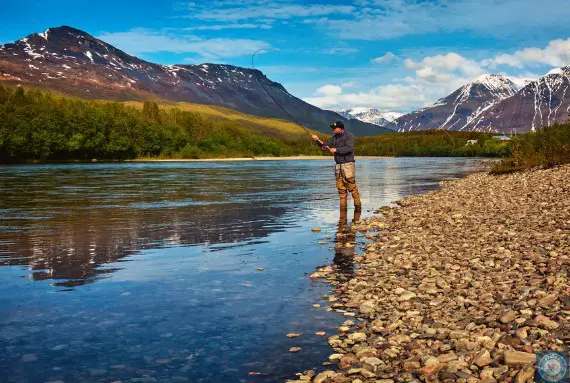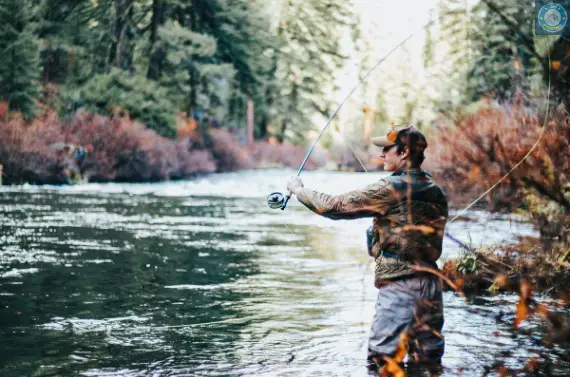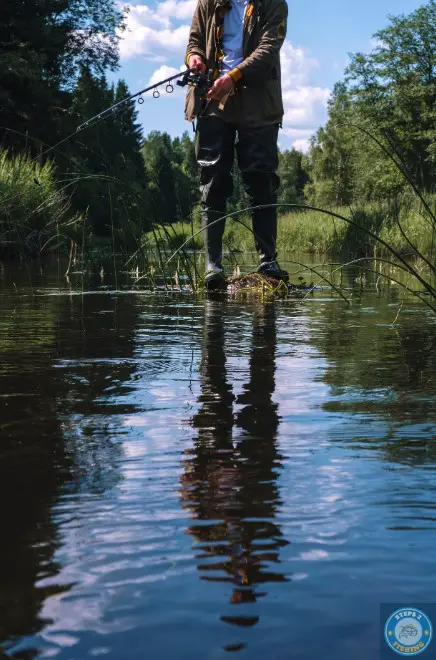
Wade fishing (wading) is a fun and exciting way to get into the angling world. It is a great way to increase your success ratio in routine fishing or catch a large fish. This guide will take you through the basics, tips, and equipment needed to begin your wade-fishing journey.

What is Wade Fishing?
Wade fishing, often called “flats fishing,” is where anglers wade into shallow waters to catch fish. This technique allows for a more intimate connection with the environment. It offers a unique opportunity to target species that thrive in shallow coastal areas.

Benefits of Wade Fishing
This technique offers numerous advantages:
- Stealthy Approach: Wade fishing allows anglers to approach fish quietly, minimizing disturbance and increasing the chances of a successful catch.
- Cost-Effective: You don’t need an expensive boat for wade fishing, making it an affordable option for many anglers.
- Physical Exercise: This technique provides an excellent workout as you navigate through water, improving cardiovascular health and strength.
- Close to Nature: Wade fishing immerses you in the natural habitat of fish, giving you a more profound connection to the ecosystem.
Wade Fishing for Beginners
Here’s a question: “Is Wade fishing suitable for beginners?”
Absolutely! Wading is an excellent choice for newcomers to the fishing scene. It offers a gentle learning curve, allowing you to grasp fishing essentials without the added complexities of boats or expensive gear.
How to Start Wade Fishing
Getting started with Wading is simpler than you think. Here are some comprehensive steps to help you in your wading adventure.
Gear Up
Initially, it would be best to have this equipment, including waders, fishing rod and reel, lures and baits, and a tackle bag. Make sure you have all these compulsory equipment for your enjoyable trip.
Essential Equipment and Tips
Waders
Choose breathable and waterproof waders for comfort and protection. Neoprene waders are ideal for colder waters.
Fishing Rods and Reels
High-quality, lightweight rods and reels suit your exciting trip and target species. A medium to medium-heavy spinning rod is versatile for wading.

Lures and Baits
Carry a variety of lures and baits, including soft plastics, topwater lures, and live bait, to adapt to changing conditions and fish preferences.

Tackle Bag
A waterproof tackle bag with multiple compartments will keep your gear organized and accessible.
Location Matters
Research and choose your location wisely for this fun. Consider factors like the types of fish you want to catch, water conditions, and accessibility. Local fishing spots or recommendations from fellow anglers can be invaluable.
Learn the Ropes
Familiarize yourself with essential fishing techniques, including casting and wading. The key to successful wading is honing your skills over time. Don’t worry; practice makes perfect!
Safety First
Always prioritize safety. Wear a personal flotation device (PFD) for added security, and be aware of water currents, tides, and weather conditions. Safety should be your top priority on every Wade fishing adventure.

Wade Fishing Techniques
Spot Selection
Identifying the right fishing spot is crucial. Look for areas with seagrass beds, oyster bars, or sandbars, as these are often teeming with fish.
Casting Techniques
Practice accurate casting to avoid spooking fish. Work on your accuracy and distance to increase your chances of a successful catch.
Stealth and Patience
Move quietly and be patient. Avoid making sudden movements that could scare away fish.
Tides and Currents
Understanding tides and currents is essential. Fish are more active during specific tidal phases, so plan your trips accordingly.
Wading in deep and fast-moving water
Wading in deep and fast-moving water is a thrilling experience for anglers, especially for fly fishermen. However, these useful tips can reduce the risks in this thrilling adventure.

Choosing the Perfect Waders
Waders are your first line of defense against water intrusion. Invest in high-quality waders that fit well and are designed for specific conditions. Consider breathable materials for comfort during extended outings.
Essential Wading Boots
Wading boots are your anchor in swift currents. Look for boots with excellent traction, ankle support, and durability. Ensure they fit snugly to prevent blisters and maintain stability in challenging terrain.

Techniques for Safe Wading in Deep Water
Proper Stance and Balance
Maintaining the right body position is crucial when wading in fast water. Keep your center of gravity low, and take slow, deliberate steps. Distribute your weight evenly and use a wading staff for added stability.
Reading the Water
Understanding the river’s flow is essential for safe wading. Identify areas of turbulent water and avoid them. Look for slow-moving pockets where you can rest and regain your footing.
Use a Wading Belt
Always wear a wading belt to prevent water from rushing into your waders in case of a fall. It provides an additional layer of security and can be a lifesaver.

Wading with friends
Whenever possible, wade with a partner. Having someone to assist you in emergencies can be a lifesaving measure.
Be Weather-Wise
Check weather forecasts before heading out. Sudden rain can increase water flow, making wading more challenging and dangerous.
Advanced Techniques
Navigating Rapids
For more experienced waders, navigating rapids can be exhilarating. However, this should only be attempted with proper training and equipment. Consider taking a swift-water rescue course to enhance your skills.

Using a Wading Staff
A wading staff can provide extra stability when you’re facing fast currents. Learn how to use it effectively to avoid falls and maintain balance.

Tips for a Successful Trip
Here are some additional tips to enhance your wade fishing experience:
Be Patient
Patience is key when Wade is fishing. Take your time, move slowly, and wait for the right moment to cast your line.
Observe Nature
Pay attention to the behavior of the fish and the water’s movement. This observation can help you anticipate where the fish might be.
Respect the Environment
Practice catch-and-release and follow all local fishing regulations to protect the ecosystem.
Share the Experience
Wading can be a fantastic bonding activity. Consider inviting friends or family to join you on your fishing adventures.
Seasonal Considerations
Understanding the seasonal fish patterns in your area can give you an edge over other anglers. Different species are more active during specific times of the year. Take note of the following:
- Spring: Excellent for speckled trout and redfish.
- Summer: Prime time for flounder and snook.
- Fall: Ideal for snook, redfish, and speckled trout.
- Winter: Great for sheepshead and black drum.

Conservation and Ethics
As responsible anglers, we must protect the environment. Practice catch and release, adhere to bag limits, and pick up any trash you encounter during your wade fishing adventures. Preserving our natural resources ensures that future generations can enjoy this incredible sport.
Conclusion
Wade fishing offers an accessible and enjoyable way to connect with nature while trying your hand at fishing. It’s an ideal choice for beginners and seasoned anglers. It provides a unique experience that allows you to feel the water, cast your line, and immerse yourself in the serene beauty of natural aquatic environments.
So, grab your gear, find a suitable fishing spot, and embark on your wade fishing journey. Remember, practice, patience, and safety are the keys to a successful and memorable wading adventure.
FAQs
Q. What is Wade Fishing?
A. Wade fishing is where anglers stand in shallow water, typically in rivers, streams, or coastal areas, and cast their lines to catch fish. This method allows you to approach fish silently and efficiently, making it a popular choice among anglers who enjoy direct contact with the aquatic environment.
Q. Where Can You Go, Wade Fishing?
A. You can wade fishing in various aquatic environments, including freshwater and saltwater. Some popular spots include rivers, lakes, estuaries, and coastal flats. Research your local fishing regulations and choose a location that suits your preferences and the type of fish you want to catch.
Q. What Gear Do You Need for Wade Fishing?
A. To start wade fishing, you’ll need some essential gear, including a fishing rod, reel, fishing line, bait or lures, and a tackle box. Additionally, protective gear like waders or water shoes is crucial to keep you comfortable and safe while wading in the water.
Q. How to Choose the Right Fishing Rod for Wade Fishing?
A. Selecting the right fishing rod for wade fishing is essential. Opt for a lightweight and durable rod with medium to fast action. This will allow you to cast accurately and effectively control your line.
Q. Are Waders Necessary for Wade Fishing?
A. Waders are only sometimes necessary for wade fishing but provide significant advantages. Waders keep you dry and comfortable, allowing you to stay in the water longer. Invest in quality waders for a more enjoyable wade fishing experience.


Leave a Reply